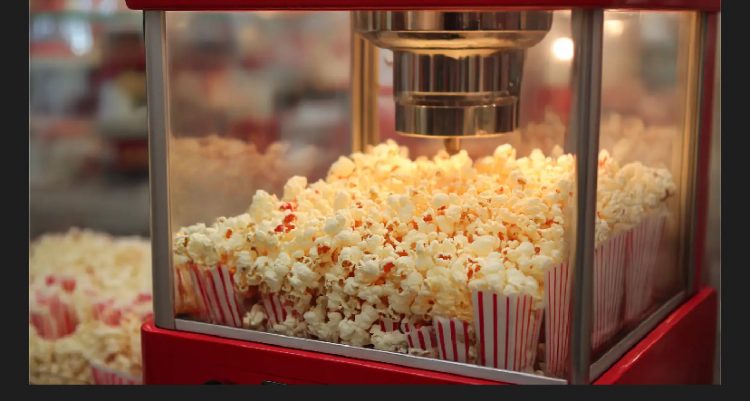The smell of fresh popcorn can transform any venue into a destination. If you’re researching a professional commercial popcorn machine for your business, you’re looking at one of the most profitable investments in the concession industry. Movie theaters, sports venues, and even retail stores use popcorn to drive traffic and profits with minimal effort and maximum return.
Popcorn has been the king of concessions for over a century, and for good reason – it’s cheap to make, easy to serve, and everybody loves it.
Commercial Popcorn Machine Basics
Understanding how commercial poppers work helps you make better buying decisions and operate them successfully.
The kettle is the heart of the machine. It heats oil and kernels to about 400°F, causing kernels to explode into fluffy popcorn. Commercial kettles range from 6 ounces for small operations to 32 ounces for high-volume venues.
Agitation keeps kernels moving so they heat evenly and don’t burn. A motor-driven stirrer ensures consistent popping and prevents scorching.
The warming deck keeps finished popcorn fresh and appealing. Heat lamps and perforated decks maintain temperature while allowing moisture to escape.
Sizing Your Popcorn Operation
Choosing the right size machine prevents both lost sales and wasted investment:
6-8 oz Kettles – Produce about 10-15 servings per batch. Perfect for convenience stores, small bars, or video rental stores.
12-14 oz Kettles – The most popular size. Makes 20-25 servings per batch. Ideal for small theaters, bowling alleys, or busy concession stands.
16-20 oz Kettles – High-volume production for busy venues. Makes 30-40 servings per batch.
32 oz and Larger – Stadium and multiplex theater machines. Can pop continuously during rush periods.
Features That Matter
Modern commercial poppers offer features that improve efficiency and profitability:
Twin Arm Kettles – Dump from either side, speeding service during rushes.
Digital Controls – Precise temperature control improves yield and quality.
Exhaust Systems – Remove moisture for crispier popcorn that stays fresh longer.
Merchandising Lights – LED lighting makes popcorn look irresistible while using less energy.
Installation Requirements
Commercial poppers need proper installation for safety and performance:
Electrical needs vary by size. Small machines might run on 120V, but larger units need 208V or 240V circuits. Never undersize electrical service.
Ventilation removes oil vapor and heat. Some jurisdictions require exhaust hoods for commercial poppers.
Location affects sales. Position where the aroma draws customers but away from high-traffic areas where hot oil could splash.
Operating for Maximum Yield
Getting the most from every batch requires proper technique:
Preheating to the right temperature ensures kernels pop completely. Cold starts waste kernels and produce tough popcorn.
Oil and seasoning ratios affect taste and cost. Most operations use 1/3 cup oil and 2 tablespoons of Flavacol per pound of kernels.
Timing matters. Dump the kettle when popping slows to 2-3 seconds between pops. Waiting longer burns the last kernels and affects batch taste.
Supply Selection and Storage
Quality supplies make quality popcorn:
Kernels – Butterfly type is standard. Buy from reputable suppliers and use within a year. Store in cool, dry places.
Oil – Coconut oil (colored and flavored) gives authentic theater taste. Some use canola for health-conscious markets.
Seasoning – Butter salt (Flavacol) is the secret. It adheres better than regular salt and provides the classic color.
Supplies – Boxes, bags, or buckets. Size options let you offer value pricing on larger servings.
Daily Operations and Maintenance
Consistent procedures ensure quality and equipment longevity:
Start each day by cleaning and preheating. A clean, hot kettle pops better.
During service, keep popcorn moving. Rotate stock so customers always get fresh product.
End of day cleaning while equipment is warm makes the job easier. Built-up carbon affects taste and efficiency.
Troubleshooting and Repairs
Common problems have simple solutions:
Burning Smell – Temperature too high or old oil in kettle. Clean thoroughly and check thermostat.
Poor Yield – Old kernels, wrong temperature, or worn agitator. Start with fresh supplies before assuming equipment problems.
Slow Popping – Usually low temperature. Check heating elements and electrical supply.
Excessive Unpopped Kernels – Could be kernel quality, insufficient heat, or wrong oil ratio.
Marketing Your Popcorn
Popcorn sells itself, but smart marketing increases sales:
Size pricing should encourage larger purchases. Make the large only slightly more than medium.
Fresh popping during slow times creates aroma that drives sales.
Combo deals with drinks increase transaction size and customer satisfaction.
Special flavors or toppings add variety and premium pricing opportunities.
Financial Considerations
Popcorn offers exceptional ROI when managed properly:
Cost per serving runs $0.15-0.30 including supplies. Selling prices of $3-8 mean margins exceeding 90%.
Equipment pays for itself quickly. A $3,000 machine selling 50 servings daily at $5 each generates $91,000 annually.
Labor costs are minimal. One person can pop and serve hundreds of customers.
The right commercial popcorn machine becomes the cornerstone of your concession operation, delivering consistent profits with minimal complexity.
Additional Resources
Popcorn Institute – Information about popcorn varieties and preparation methods.
National Association of Concessionaires – Training and certification for concession operations.









